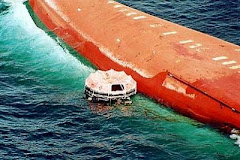
Sinking
The Estonia disaster occurred on September 28, 1994 between about 00:55 to 01:50 (UTC+2) as the ship was crossing the Baltic Sea, en route from Tallinn, Estonia, to Stockholm, Sweden. The Estonia was on a scheduled crossing with departure at 19:00 in the evening on September 27. She had been expected in Stockholm the next morning at about 09:30. She was carrying 989 passengers and crew.
According to the final disaster report the weather was rough, with a wind of 15 to 20 m/s (29–39 knots/33–45 mph), force 7–8 on the Beaufort scale and a significant wave height of 3 to 4 meters (10–13 ft) compared with the highest measured significant wave height in the Baltic Sea of 7.7 metres (25.3 ft). Esa Mäkelä, the captain of MS Silja Europa who was appointed on scene commander for the subsequent rescue effort, described the weather as "normally bad", or like a typical autumn storm in the Baltic Sea. All scheduled passenger ferries were at sea.
The official report says that while the exact speed at the time of the accident is not known, Estonia had very regular voyage times, averaging 16–17 knots, perhaps implying she did not slow down for adverse conditions. The chief mate of the Viking Line cruiseferry MS Mariella tracked Estonia's speed by radar at approximately 14.2 knots before the first signs of distress, while the Silja Europa's officers estimated her speed at 14–15 knots at midnight.
The first sign of trouble onboard the Estonia was a strange sound of metal against metal heard around 01:00, when the ship was on the outskirts of the Turku archipelago; but an investigation of the bow visor showed no obvious damage. At about 01:15, the visor separated and the ship took on a heavy starboard list. At about 01:20 a weak female voice called "Häire, häire, laeval on häire", the Estonian words for "Alarm, alarm, there is alarm on the ship", over the public address system. Just a moment later an internal alarm for the crew was transmitted over the public address system. Soon after this the general lifeboat alarm was given. Soon the vessel lurched some 30 to 40 degrees to starboard, making it practically impossible to move about safely inside the ship. Doors and hallways became deadly pits.

Those who were going to survive were already on-deck by then. A Mayday was communicated by the ship's crew at 01:22, but did not follow international formats. Due to loss of power, she could not give her position, which delayed rescue operations somewhat. The ship disappeared from the radar screens of other ships at around 01:50. Mariella arrived at the scene of the accident at 02:12; the first rescue helicopter arrived at 03:05.
Out of a total of 989 passengers and crew on board 137 were saved. The accident claimed 852 lives (501 Swedes, 280 Estonians, 23 Latvians, 10 Finns and 19 people of other nationalities), by drowning and hypothermia, (the water temperature was 10°C–11 °C/50–52 °F). 92 bodies were recovered.

The official report blamed the accident on the failure of locks on the bow visor, that broke under the strain of the waves. When the visor broke off the ship, it damaged the ramp which covered the opening to the car deck behind the visor. This allowed water into the car deck, which destabilized the ship and began a catastrophic chain of events. (Flooding on the car deck capsized the Herald of Free Enterprise, where the bow doors were left open, and the Princess Victoria, which sank in the same storm which caused the North Sea Flood of 1953. Roll-on/roll-off ferries are particularly vulnerable to capsizing due to the free surface effect if the car deck is even slightly flooded.)
The location of the hull is at 59°23′N, 21°42′E, about 22 nautical miles (41 km) on bearing 157° from Utö island, Finland. She lies in between 74 and 85 meters (243–279 ft) of water.

Official investigation and report
The wreck was examined and videotaped by remotely operated submersibles (ROVs) and by divers from a Norwegian company, Rockwater A/S, that was contracted for the investigation work. It was discovered that the locks on the bow door had failed and that the door had separated from the rest of the vessel. The official report indicated that the bow visor and ramp had been torn off at points that would not trigger an "open" or "unlatched" warning on the bridge, as is the case in normal operation or failure of the latches. There was no video monitoring of this portion of the vehicle bay either. However, a video camera monitoring the inner ramp showed the water as it flooded the car deck. If the crew had known of the condition it is likely that they would have slowed the ship or even reversed its motion, which might have prevented the swamping and sinking. Recommendations for modifications to be applied to similar ships included separation of the condition sensors from the latch and hinge mechanisms, and the addition of video monitoring.
See an official report on Estonia ferry disaster:






No comments:
Post a Comment